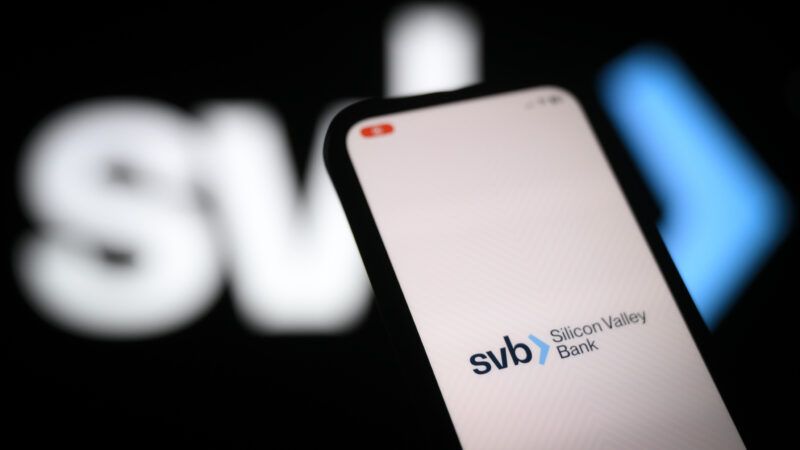How the Fed Broke Silicon Valley Bank
The Fed's anti-inflation measures had to hurt someone.

The Federal Reserve is in the unenviable position of achieving its mandate by crashing the economy. It's not something it wants to do, as Fed Chair Jerome Powell meekly admitted in his exchange with Sen. Elizabeth Warren (D–Mass.) last week. But it's something that happens as an unavoidable outcome of slowing down an economy littered with excess money and inflation. Broad money growth has been negative since late November, and interest rate expenses on everything from corporate borrowing to credit cards to the government's own debt have been rising fast.
This hiking cycle, the fastest that the Fed has embarked upon in a generation, was always likely to break something. And break something they did over the weekend, from the regulated stablecoins USDC and Gemini Dollar, which lost their dollar pegs, to Silicon Valley Bank (SVB), which faced the second-largest bank run in U.S. history. If one weren't so hung up on labor markets, inflation figures, and congressional soundbites, presumably these are the sort of things that a monetary authority like the Fed is tasked to manage. Oops.
In Powell's back-and-forth with Warren, the senator pointed to "things you can't fix with high interest rates—things like price gouging, supply chain kinks and the war in Ukraine." Regardless of how little sense those arguments make, our favorite senator is accidentally correct: monetary policy is about money and assets and banks, with only limited (residual) influence over things in real markets.
Barking up the wrong trees—unemployment, market power—Warren missed an opportunity to examine the things that really are breaking. Around the same time she spoke those words and Powell defended the Fed's action, SVB was desperately trying to raise new money. The effort failed, and plenty of tech investors, including Peter Thiel's Founders Fund, pulled their mostly uninsured deposits at the bank as quickly as they could.
According to Bloomberg, bank CEO Greg Becker asked creditors on a call Thursday to "support the bank the way it has supported its customers over the past 40 years"—as if any bank run had ever been stopped by asking nicely.
The losses in SVB's Treasury portfolio—courtesy of the Fed's quick rate hikes, which crashed the bond market last year—amount to billions of dollars in unrealized losses. The accounting rules of "held to maturity" allows banks to ignore mark-to-market losses if the securities are intended to be held until they come due. Of course, holding to maturity requires you to finance the securities in the meantime, something that's pretty much impossible when your customers don't think you'll make it and instead are demanding their deposits back en masse.
If we ignore this accounting trick, Silicon Valley Bank was already "insolvent" by September of last year, when the unrealized bond losses exceeded its equity.
Towards the end of last year, some $25 billion of deposits ran off as SVB's customers drained their bank deposits to withstand the business pressures of inflation and a thriving venture capital industry dying down. Another $10 billion followed in the early months of 2023, and who knows how much managed to escape over the last few days—Fortune reports $42 billion on Thursday alone—before management threw in the towel on Friday and had the bank placed into the Federal Deposit Insurance Corporation's receivership.
Because Treasuries are "risk-free" and therefore carry lower capital requirements for banks to hold against them, banks allocate more of their funds to them. This concentrates banking system risk in a single interest-sensitive security. SVB is just the most extreme and reckless version of a risk present in most American banks. For reference, the rest of the U.S. banking system has unrealized losses amounting to more than $600 billion, some 25 times more than the losses that just brought down SVB.
There's no shortage of blame to place on regulators for having engineered such an unnatural banking market. Far from making banks "safe," the regulatory system concentrates risks, with the alphabet soup of Fed liquidity facilities standing ready to money-print their way out of any trouble.
As Caitlin Long, CEO of Custodia Bank, pointed out on Saturday, this pushes the Fed into a very delicate position: risk systemic bank runs, or roll back the hikes and quantitative tightening that caused this mess, printing money for an even hotter inflation.
6/ * on interest rates—mkt action Thurs/Fri means bond mkt already smells end of Fed QT, which disproportionately sucked deposits out of community banks. Recognize, tho, that a Fed pivot wld keep inflation running hot. Trade-off btwn systemic bank run vs hot inflation—hot potato
— Caitlin Long ????⚡️???? (@CaitlinLong_) March 11, 2023
Most awkward of all, here's what Michael Barr, the Fed vice chair for supervision, said in a speech Thursday as the run was in full swing: "The banks we regulate, in contrast, are well protected from bank runs through a robust array of supervisory requirements." Double-oops.
The stablecoins that Barr was railing against did indeed break over the weekend. The kicker is that it was the transparently audited ones—whose sponsors have been cozying up to U.S. regulators in recent years—who broke their pegs. The eternal scapegoat Tether, shrouded in mystery, investigated and fined by the New York attorney general in 2021, traded at a premium of as much as 3 percent on Saturday. Everything, it seems, is upside down.
Through the magic of "held to maturity," perhaps all the other banks can endure the storm and come out the other side without the same losses that SVB was forced to book last week. It certainly gets easier to harbor underwater securities on your books when the Fed stands ready to finance them for you.
Hang on to your hat—or in this case, your bank account. Because Sen. Warren is right about one thing: "The Fed has a terrible track record in containing modest increases in the unemployment rate."
And last week, something already broke.


Show Comments (137)